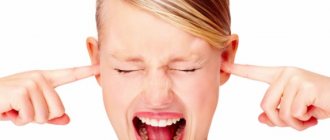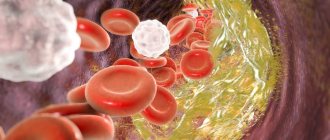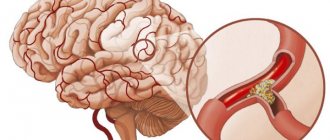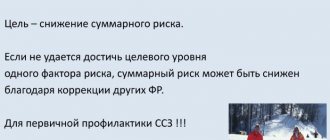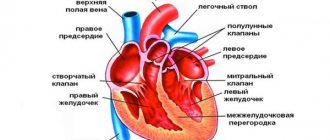Blockage of a vessel is fraught with serious consequences
Mild spasm of cerebral vessels is commonly called hypertonicity.
The disease is insidious due to the narrowing of blood vessels due to a decrease in the lumen between their walls.
Ignoring it can lead to serious changes in the functioning of related systems and organs.
A harbinger of the disease are frequent dizziness, malaise, and headaches. Less commonly, patients experience blurred vision, ringing in the ears, and nausea.
Hypertonicity of the brain can occur against the background of alcohol addiction, stress, overwork, and smoking.
What are its features
Vascular tone refers to the tension of the walls, which is ensured under the influence of smooth muscles. The latter has different severity, based on where it is located (arteries, veins, capillaries):
- the greatest severity is seen in the area of the arteries: smooth muscles provide high resistance to blood pressure and constantly maintain the arterial lumen;
- the least pronounced is in the area of the veins: the layer cannot resist the pressure of the blood flow and maintain the venous lumen;
- there is no smooth muscle in the capillaries.
The tone of cerebral vessels (brain) is maintained by 2 mechanisms: neurogenic (nerve impulses) and myogenic (spontaneous contraction of the smooth muscle layer).
Trauma, surgery, stroke, pathologies of the ANS (for example, vegetative-vascular dystonia), intoxication syndrome, the development of certain diseases of infectious and endocrine etiology often become causes of disruption of neurogenic regulation of tone. In this case, the smooth muscle muscles contained in the vessels take over the implementation of normal blood circulation. This process is called basal tone. It is provided through the myogenic regulatory mechanism.
Vascular reflexes
Vascular reflexes are divided into:
- own and
- conjugated.
Own reflexes
They are carried out from mechanoreceptors located in the heart and blood vessels ( baroreceptors ).
These receptors stabilize blood pressure.
There are own reflexes:
- pressor - increasing low blood pressure,
- depressor - lowering high blood pressure.
Reflexogenic zones (areas of maximum accumulation of receptors):
- aortic arch,
- carotid sinus (bifurcation of the common carotid artery into external and internal).
Depressor reflex: with an increase in blood pressure -> the baroreceptors of the aortic arch and carotid sinus are irritated -> excitation along the sensory nerves - aortic (depressor) and sinus (Hering's nerve) -> medulla oblongata -> the vagal center is excited and the vasomotor center is inhibited -> heart rate decreases - > blood vessels dilate -> blood pressure decreases (normalizes).
When blood pressure drops, the opposite is true, that is, the pressor reflex .
Own reflexes:
- are also carried out from chemoreceptors located in the aortic and carotid bodies;
- they are excited when CO2 and H ions increase in the blood and when O2 decreases;
- impulses arriving from chemoreceptors in the medulla oblongata increase the tone of the central nervous system, which leads to an increase in pressure.
Chemoreceptors are not in the vessel wall, but in the aortic and carotid bodies or glomeruli under the adventitia of the vessel and are penetrated by a network of capillaries.
From chemoreceptors -> SDC of the medulla oblongata -> SDC is excited -> vasoconstriction -> increase in blood pressure -> rapid blood renewal.
Conjugate reflexes
Carried out from receptors located outside the heart and blood vessels:
- they disrupt the stability of blood pressure, causing pressor reactions;
- distinguish conjugate reflexes: exteroceptive - from skin receptors,
- interoceptive - from internal organs.
Types of changes in vascular tone
The tone of cerebral vessels can be decreased or increased. In the first case, there is hypotonicity, in the second - hypertonicity, the features of which are different.
Hypotonicity
Hypotonicity or hypotension is a decreased vascular tone, which is expressed in a decrease in blood flow volume and a drop in pressure in the arteries. When the tone of small vessels decreases, the flow of blood into the organ increases. The walls of the arteries are stretched during contraction of the ventricles of the heart (one of the states of the organ's muscle), thereby causing throbbing headaches.
If the tone of the small veins located in the brain decreases, there is difficulty in the outflow of blood from the organ. It is in the area of veins and venous sinuses that the largest volume of blood is localized. When a person is lying down, when the head is below the level of the neck (when bending forward or throwing it back), during physical exertion and emotional overload, blood flow is further disrupted, causing bursting headaches.
Hypertonicity
Hypertonicity of cerebral vessels is an increase in their tone, that is, the degree of wall tension, which causes an increase in resistance to blood flow. Hypertonicity is characterized by an increase in blood pressure and the occurrence of corresponding symptoms.
Hypertonicity, like hypotonicity, can occur against the background of the following pathological conditions of the body:
- constant lack of sleep and overwork;
- abuse of invigorating drinks (coffee, tea, etc.), alcohol, smoking;
- long stay in a stuffy room;
- frequent emotional experience, stress;
- development of hormonal disorders;
- VSD;
- development of atherosclerosis or osteochondrosis;
- heart and kidney diseases.
Spasm of the walls of blood vessels contributes to the narrowing of the lumen of the latter, causing a decrease in the volume of passing blood. Hypoxia develops, and with significant narrowing of the lumen, tissue ischemia.
Causes
The following reasons lead to spasm of cerebral arteries and veins, which are divided into psychological (neurological, psychiatric), somatic (bodily) and indirect.
Psychological reasons:
- Anxiety disorder, accompanied by excitement, fear due to constantly elevated levels of adrenaline.
- Vegetovascular dystonia. The disease is characterized by an imbalance between the functioning of the autonomic parts of the nervous system. In this disease, blood vessels spasm for no obvious reason.
- Stress, neuropsychic tension.
- Sleep disturbance: insomnia, taking a long time to fall asleep.
- Personality pathologies: psychopathy, accentuation. This is predominantly a hysterical, emotionally labile and cycloid personality type.
Somatic causes:
- Arterial hypertension - as a primary disease - a persistent increase in blood pressure over 140/80 for more than two weeks.
- Atherosclerosis is the presence of fatty deposits on the walls of the arteries.
- Inflammation of the walls of blood vessels.
- Diseases involving systems: rheumatoid arthritis, systemic lupus erythematosus or scleroderma.
- Diseases of the endocrine organs: pheochromocytoma is a tumor of the adrenal glands that sharply stimulates the glands and provokes the release of huge amounts of adrenaline.
- Dystrophic diseases of the musculoskeletal system: cervical osteochondrosis, spinal hernia.
- Hyperthyroidism. What it is? This is a disease of the thyroid gland, in which the release of T3-T4 hormones increases, which increases the sensitivity of blood vessels to adrenaline and norepinephrine.
- Inflammation of the tissue of the nerve ganglia of the sympathetic parts of the autonomic nervous system.
- In children, cerebral ischemia is observed due to pathologies during pregnancy and complicated childbirth. As a rule, a child’s pathology is diagnosed immediately in the maternity hospital.
Indirect reasons that increase the likelihood of hypertension:
- smoking;
- large doses of caffeine: more than three cups of coffee per day; caffeine temporarily stimulates the release of adrenaline into the blood;
- diabetes;
- heredity;
- age: from 50 years old, mostly men;
- prolonged stay in stuffy, unventilated rooms;
- weather sensitivity.
Symptoms
The signs and characteristic manifestations of increased and decreased vascular tone are significantly different.
Hypotonicity
The main symptom of hypotonicity of the cerebral arteries is a dull, pressing, bursting headache, which is localized in the back of the head and temples.
The general condition is disturbed: a person is worried about weakness, malaise, which arise for no apparent reason. Mood and emotional state changes. A person may suffer from insomnia, and patients with hypotension often experience vomiting. Shortness of breath and arrhythmia develop even with minor physical activity.
Sweating increases, dizziness occurs, especially when getting up from a support.
Hypertonicity
In most cases, hypotension (hypertension) begins sluggishly, without obvious symptoms. A person attributes the first symptoms to banal overwork. Characteristic signs of hypotonicity at the initial stage include general malaise, the appearance of “goosebumps” before the eyes, and a low-intensity headache.
Additional clinical manifestations of hypertension include:
- increased sweating;
- redness of the skin on the face;
- swelling of the hands that occurs in the morning;
- memory impairment.
As hypertension progresses, painful headaches, dizziness, and chest pain occur. The risk of stroke increases and visual function is impaired.
In severe cases, if treatment measures are not followed, angina pectoris, heart failure, myocardial infarction, arrhythmia and other dangerous pathologies may develop.
Problem in newborns
Pathologically altered vascular tone in infants is a dangerous phenomenon, which, if treatment is not started in a timely manner, can be fatal or cause the child to be assigned a disability group.
The most common consequence of insufficient oxygen supply to the brain with impaired vascular tone is cerebral ischemia. In this case, brain cells are inhibited due to insufficient blood supply, including oxygen. In approximately 40% of cases, the newborn dies.
To date, there is no specific treatment for cerebral ischemia in infants. Despite this, maintenance therapy can be started, which helps prevent complications and reduce the intensity of clinical manifestations.
Oxygen starvation can begin while the fetus is in the womb or during labor. During the prenatal period, this process is influenced by the following factors:
- alcohol and smoking abuse by a pregnant woman;
- development during pregnancy of an infectious disease, pathology of an endocrine nature, ARVI;
- age of the pregnant woman (before 18 years and after 35);
- high degree toxicosis in the third trimester.
Problems during labor also affect the condition of the baby’s brain. This:
- large fruit;
- use of drug stimulation of labor;
- premature birth;
- complications during childbirth, including birth injuries;
- entwining the fetus with the umbilical cord.
Treatment and therapy
To treat hypotension of cerebral vessels, an integrated approach and combination therapy are used. A course of treatment is usually prescribed to patients only after examination by a cardiologist and neurologist. After examining the patient and collecting anamnesis, a full clinical examination should be carried out, which includes the following tests:
- General and biochemical blood tests.
- Study of blood viscosity and coagulation rate.
- Dopplerography of cerebral vessels.
- Angiography of blood vessels.
Patients with hypotension should follow a diet, lead a healthy lifestyle, move more, and exercise. Among the medications used in the treatment of cerebral vascular hypotension, the following methods are used:
- Medications containing caffeine are used as first aid. They are used for a short period of time because they have only a symptomatic effect, but they are not used for permanent therapy.
- Nootropic drugs are used as maintenance therapy, which include aminalon, nootropil, phenibut and others.
- For depression and migraine-like pain, the drugs encephabol, stugeron, tanakan are prescribed, which accelerate blood flow and tone the walls of blood vessels.
- Herbal preparations have a good therapeutic effect for hypotension, of which ginseng root, Rhodiola rosea extract, Eleutherococcus tincture, liquid Leuzea extract and others are often used.
- Treatment with amino acids is used as nutrition and building material for blood vessels, many of which have the properties of neurotransmitters (substances that transmit signals between cells of the nervous system). Among the amino acids, glycine, glutamic and gamma-aminobutyric acids are used.
Basic treatment
How to improve vascular tone? Treatment methods may differ depending on whether a person has a decrease or increase in tone. To determine the tone, appropriate studies are carried out (rheoencephalography, etc.), based on the results of which a final diagnosis is made (hypotension or hypertension).
Hypertonicity
It is recommended to start therapy for hypertension as early as possible, before the pathology has time to become chronic. To strengthen the walls of blood vessels, you need to follow some simple recommendations:
- giving up bad habits (smoking, drinking alcohol);
- taking preventive courses of cervical-collar massage;
- maintaining proper nutrition;
- timely cure of infections;
- maintaining an active lifestyle.
Physical activity should be moderate. You should not overload the body and lift weights, because this affects not only the blood vessels, but also all other organs and systems.
Among the medications to eliminate hypertension are Papazol, Eufillin, Revalgin, used intravenously. The medicine Papaverine is often used. Adaptogens, nootropics, and vasoactive calcium antagonists are prescribed. First aid medications for headaches - Spazgan, Nurofen, Spazmalgon.
Hypertonicity is also treated with cool baths, which help relax smooth muscles. The patient’s diet, which should be low in calories, is important.
Hypotonicity
The treatment strategy for hypotension is as follows:
- maintaining a healthy lifestyle;
- maintaining proper nutrition and rational physical activity;
- daily walks in the fresh air.
To eliminate the unpleasant symptoms of the disease, medications containing caffeine are prescribed. With dilated blood vessels, nootropic drugs will come to the rescue.
Medicines that help activate blood flow and strengthen vascular walls will help relieve depression and eliminate migraine-like headaches: Encephabol, Tanakan, etc. You can strengthen blood vessels with the help of drugs that contain amino acids.
Just as with hypertension, hypotension is treated with physiotherapeutic procedures and diet.
Folk remedies
There are many folk methods that are used to strengthen blood vessels:
- Mix chamomile, St. John's wort, immortelle, birch buds and yarrow in equal proportions. For the full course of treatment you will need 1 glass of dry raw materials of each medicinal plant. 1 tbsp. collection, pour 500 g of boiling water and leave for 2-3 hours. After this, the infusion is filtered, a little honey is added and taken 2 times a day - in the morning on an empty stomach and in the evening before bed. The course of treatment must be completed every 4 years. This product cleanses blood vessels and restores their elasticity.
- To strengthen blood vessels, you can take medicine made from garlic and cranberries. Take cranberries and garlic in equal proportions, grind using a meat grinder or blender and let it brew for 3 days. After this, the mixture must be thoroughly squeezed out. Add a little honey to the resulting juice (to improve taste) and take 1 tbsp before meals. 2 times a day.
- Take 5 walnut kernels, chop, add 1 tbsp. honey and leave for 1 day. This medicine should be taken 4 times a day, 1 tbsp. The course of treatment is 30 days. This cleaning of vessels is carried out 2 times a year.
Other recommendations not related to the use of medications:
- play sports: walking, running, swimming, but do not overdo it with the choice of load volume;
- take a contrast shower once a day and visit the bathhouse as often as possible;
- place a massage mat near the bed to improve blood circulation in the legs;
- learn to alternate work and rest.
Additional treatment
Therapy for pathologically altered tone in an adult or child can be supplemented with folk remedies, which are considered absolutely safe. In addition, they are not inferior in effectiveness to generally accepted medications, and are much cheaper, if not free at all. To prepare them, just have simple ingredients on hand:
- herbs (chamomile, linden, St. John's wort, etc.): throughout the day it is recommended to drink not ordinary tea, but an infusion or decoction of medicinal herbs;
- garlic, honey, lemon: consuming such products helps normalize vascular tone and eliminate spasms;
- garlic and alcohol, from which an infusion is prepared, taken orally, 2 drops at a time, diluted with milk: chop 2 heads of garlic, pour in 200 ml of alcohol, leave for 1 week, strain;
- walnuts (partitions): pour a handful of partitions with hawthorn infusion, leave for 1 week, take 1 tsp orally. before eating;
- horse chestnut and vodka: grind a handful of chestnuts in a meat grinder, pour in 200 ml of vodka, leave for 1 week, strain, take 5 ml orally on an empty stomach.
To eliminate vascular spasm, you can wipe your face and neck with ice cubes made from decoctions or infusions of medicinal herbs. The latter can be added to baths when bathing or used as compresses.
In any case, treatment for altered (increased or decreased) cerebral vascular tone should be prescribed by a doctor. The cause of the changes is taken into account, as well as concomitant diseases and the general condition of the patient. There is no need to self-medicate, which rarely leads to recovery.
Vascular tone
Tone is the tension created by the asynchronous contraction of the SMC of the middle layer of the vascular wall, which has automaticity.
Tone components:
- basal tone,
- humoral,
- central (neurogenic).
Mechanisms for regulating vascular tone:
- Local mechanisms that ensure blood flow through individual organs and tissues, that is, controlling the amount of blood flow in individual regions.
- The central mechanisms regulating systemic blood circulation are the constancy of blood pressure, blood flow, blood volume, etc.
Local regulatory mechanisms
The principle of local regulation is to ensure the independence of blood flow in organs from changes in systemic hemodynamics, that is, the provision of blood to a given region in its interests.
Local mechanisms for regulating blood vessel tone include :
- myogenic,
- metabolic.
Myogenic mechanism:
- myogenic autoregulation is characteristic of the vessels of the brain, kidneys, heart, liver, celiac region, that is, regions where it is necessary to maintain constant blood flow;
- an adequate stimulus to SMCs is their stretching;
- with an increase in blood pressure (BP) -> stretching of the vascular walls -> contraction of the SMC of the vessels -> an increase in vascular tone and maintaining the same lumen -> the blood flow in the vessels does not change;
- a decrease in blood pressure causes a decrease in vascular tone due to relaxation of the SMC: in this case, despite the decrease in blood pressure, the flow of the same volume of blood into the vessels remains,
- Thus, the amount of basal tone is influenced by the level of blood pressure.
Metabolic mechanism:
- metabolic products, dilating blood vessels, increase blood flow in working organs;
- as a result of insufficient supply of oxygen and nutrients to the region, metabolites accumulate in the tissues and blood flow increases due to the expansion of precapillaries.
Vascular tone decreases with a decrease in oxygen and carbon dioxide pressure, an increase in H and C3H6O3 ions and temperature - as a result, blood flow in working organs increases in proportion to their activity.
Central regulatory mechanisms
- nervous (reflex),
- humoral.
Nervous mechanisms
Vasomotor - vasomotor nerves:
- vasoconstrictors - vasoconstrictor nerves,
- Vasodilators are vasodilating nerves.
Vasoconstrictors
- All vasoconstrictors are sympathetic adrenergic nerves.
- The vasoconstrictor effect occurs when norepinephrine (NA) acts on α-adrenergic receptors.
- Impulses through sympathetic vasoconstrictors constantly arrive to the vessels from the neurons of the lateral horns of the thoracolumbar segments of the SC with a frequency of 1-3 impulses/s, maintaining resting tone.
- At a frequency of more than 3 pulses/s (from 3 to 15) - increased tone.
Vasodilators
- Parasympathetic cholinergic nerves:
- chorda tympani - drum string - dilates the vessels of the submandibular salivary gland;
- n. lingualis - lingual nerve - dilates the vessels of the tongue;
- n. glossopharyngeus - glossopharyngeal - dilates the vessels of the tonsils, posterior third of the tongue, parotid salivary gland;
- n. pelvicus - pelvic - dilates the vessels of the area of the same name.
- Sympathetic nerves:
- cholinergic, innervating vessels of skeletal muscles;
- adrenergic - a vasoconstrictor effect occurs when NA acts on β-adrenergic receptors in the vessels of the heart, brain and lungs.
- Dorsal root sensory nerves - dilate skin vessels according to the axon reflex (mediator - ACh).
Axon reflex:
- dilation of skin blood vessels is observed when insects bite, under the influence of mustard plasters, rubbing, scratching the skin;
- blood vessels that do not have special vasodilators dilate due to a decrease in the tone of vasoconstrictors (for example: in the abdominal organs).
Impulses along the vasomotor nerves to the vessels constantly come from the vasomotor center (VMC) .
The main localization of the vasomotor center is in the medulla oblongata (Ovsyannikov, 1871).
We recommend
Online English courses with strong teachers from Inglex. For visitors to our website we give 3 lessons using the promotional code WELCOME when paying for 5 lessons with Russian-speaking teachers
Start learning English
